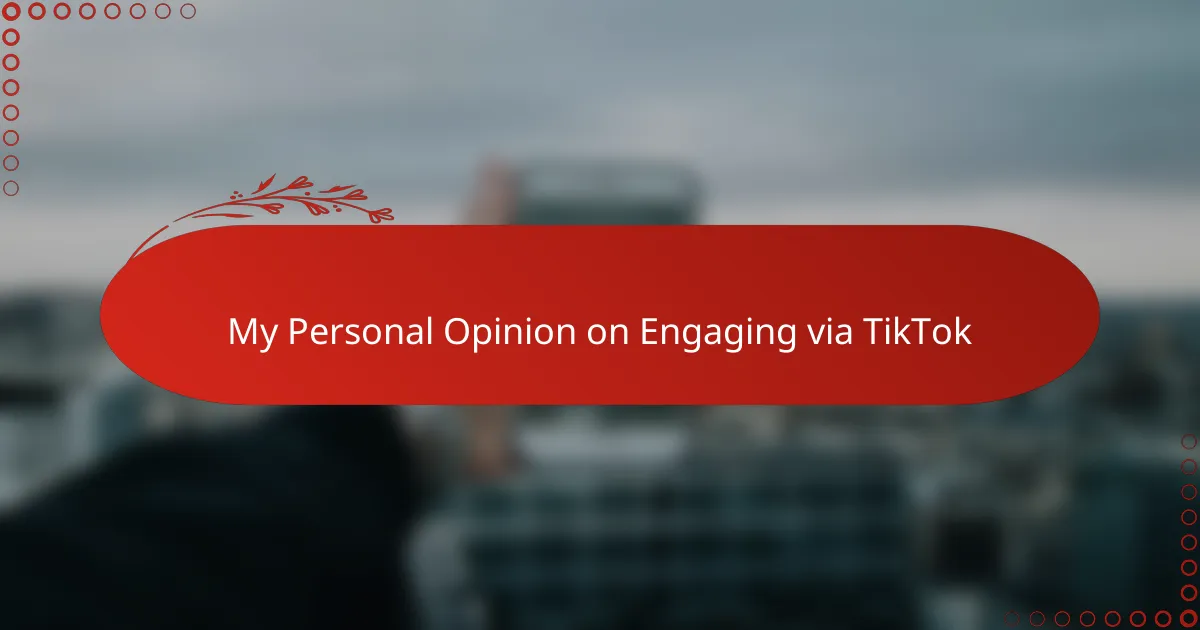Key takeaways
- TikTok offers radio broadcasters a platform for creativity through short, engaging content that can reach a younger audience.
- The algorithm assists in targeting and engaging the right listeners, making content discovery more efficient than traditional radio methods.
- Real-time feedback on TikTok allows for immediate audience interaction, fostering a sense of community and connection.
- Adapting storytelling to TikTok’s fast-paced format encourages broadcasters to distill their messages, making content more impactful.
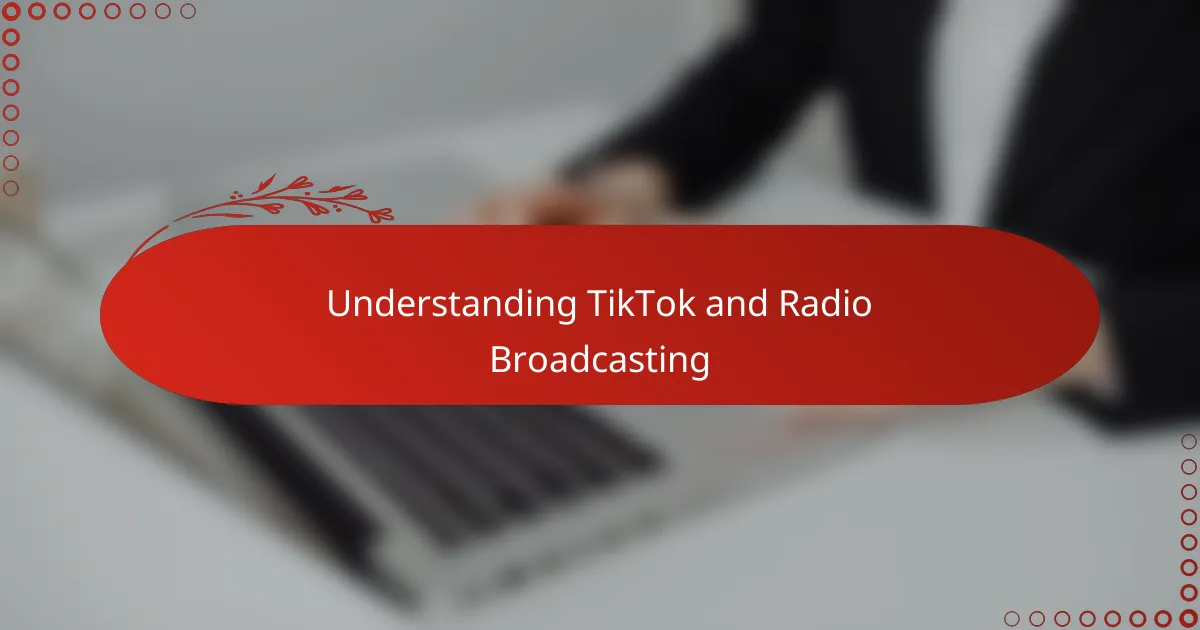
Understanding TikTok and Radio Broadcasting
When I first encountered TikTok, I was struck by how it transformed simple content into a rapid, engaging experience. Unlike traditional radio broadcasting, which unfolds over a longer period and relies heavily on voice and sound, TikTok captivates through quick visuals paired with catchy audio snippets. This made me wonder: can the essence of radio survive in such a fast-paced, visually driven platform?
The beauty of radio has always been its intimate connection—listeners imagining stories through sound alone. TikTok challenges this by offering immediacy and shareability, but it also provides a new canvas for broadcasters to experiment with short bursts of creativity. From my experience, merging these two worlds can refresh how we engage audiences, even if it feels unusual at first.
I often ask myself, how can radio broadcasters embrace TikTok without losing their authentic voice? The answer lies in understanding that both mediums thrive on connection, just expressed differently. This insight has changed how I view engagement—it’s not about abandoning tradition but evolving it to meet listeners where they are today.
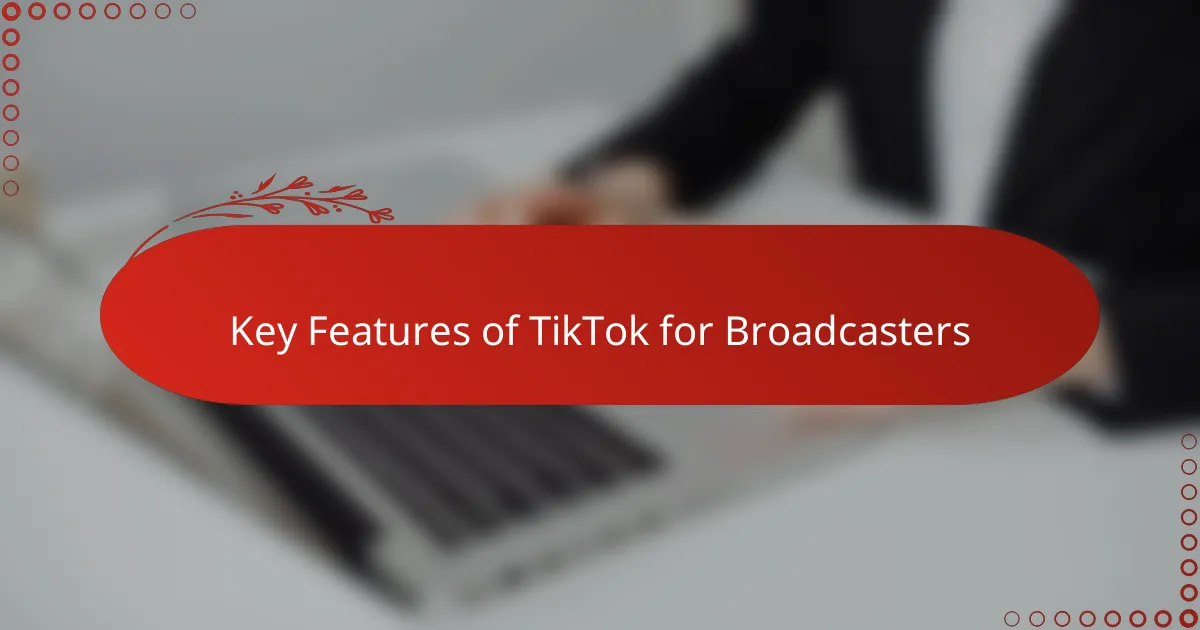
Key Features of TikTok for Broadcasters
One key feature that caught my attention is TikTok’s algorithm, which feels almost like a personal assistant for broadcasters. It quickly learns what your audience likes and serves your content to those most likely to engage. This surprised me because, in radio, reaching the right listeners often requires careful scheduling and guesswork, while TikTok does much of the heavy lifting automatically.
Another aspect I appreciate is the platform’s duet and stitch functions. These tools invite collaboration and conversation, allowing broadcasters to respond to trends or audience reactions instantly. I remember trying a duet once and was amazed at how it sparked dialogue with listeners in a way traditional call-ins never could during a live show.
Lastly, TikTok’s emphasis on short-form content forces broadcasters to rethink storytelling. Can you really convey your message in 15 to 60 seconds? It challenged me to distill stories to their essence while keeping them catchy and compelling — a skill that proves invaluable even beyond the app. Have you noticed how this brevity shapes creativity under pressure? I certainly have, and it’s been a game changer.
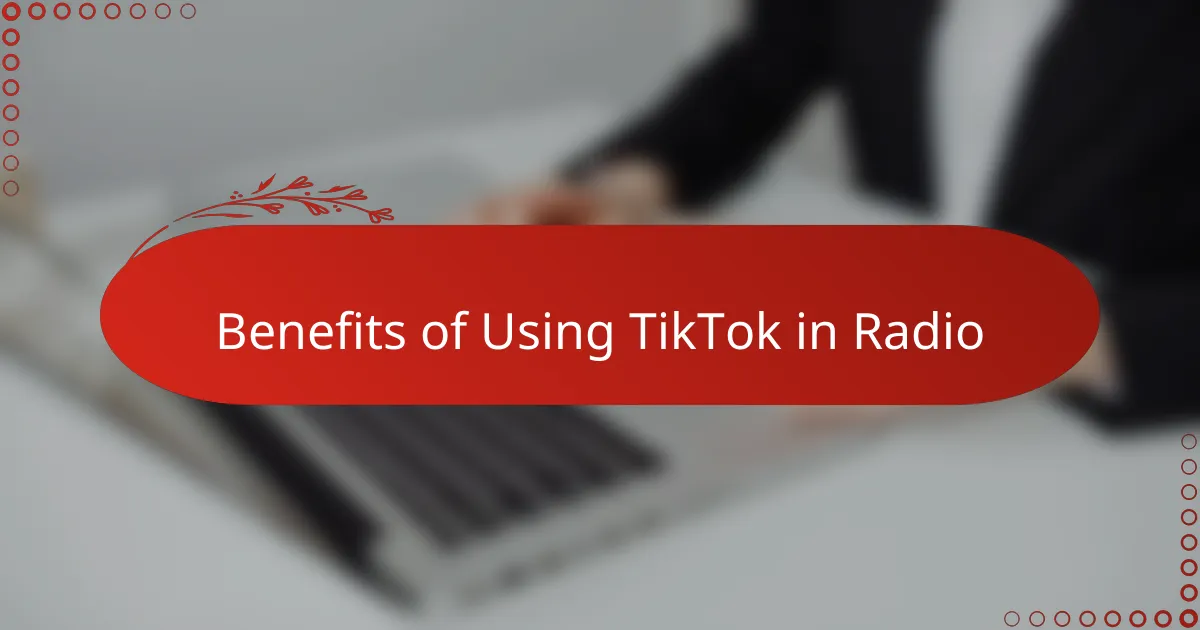
Benefits of Using TikTok in Radio
Using TikTok in radio has opened up surprising benefits for me, especially when it comes to reaching younger audiences who might not tune into traditional broadcasts. The platform’s quick, visual style breathes new life into radio content, making it accessible and exciting. Have you ever wondered how a twenty-second clip could capture as much attention as an hour-long show? I’ve found it can, with the right approach.
Another advantage I’ve experienced is the instant feedback TikTok provides. Unlike radio, where listener reactions are often delayed or indirect, TikTok’s comments and shares show me exactly what resonates. This real-time connection not only sharpens my content but also builds a sense of community that feels more vibrant than ever before.
Finally, TikTok pushes me to be more creative and experimental with radio content, something I hadn’t prioritized until now. The platform encourages risk-taking in a way that traditional radio’s format sometimes restricts. Have you noticed how trying new formats or topics on TikTok can spark unexpected engagement? I certainly have, and it keeps the work fresh and thrilling.

Strategies to Engage Audience on TikTok
When I first started using TikTok for radio content, I quickly realized that consistency matters more than perfection. Posting regularly—even short clips or behind-the-scenes moments—creates a steady rhythm that hooks viewers. Have you ever noticed how repeated exposure builds familiarity? That’s exactly what TikTok’s audience craves, and it made me rethink the “one big show” approach I was used to.
Another strategy I’ve found effective is jumping on trends but adding a personal twist. TikTok thrives on viral sounds and challenges, yet simply copying feels hollow. When I inject my unique broadcasting style or share relatable radio anecdotes through trending formats, engagement spikes. It’s like leveraging popular culture without losing my authentic voice, a balance that feels both rewarding and natural.
Finally, engaging directly with viewers through comments or video replies transforms passive watchers into active participants. I remember answering a curious follower’s question about radio equipment in a stitch video—it sparked a lively conversation and even inspired ideas for future broadcasts. Have you tried turning audience questions into content? From my experience, this two-way connection is where true engagement blossoms.
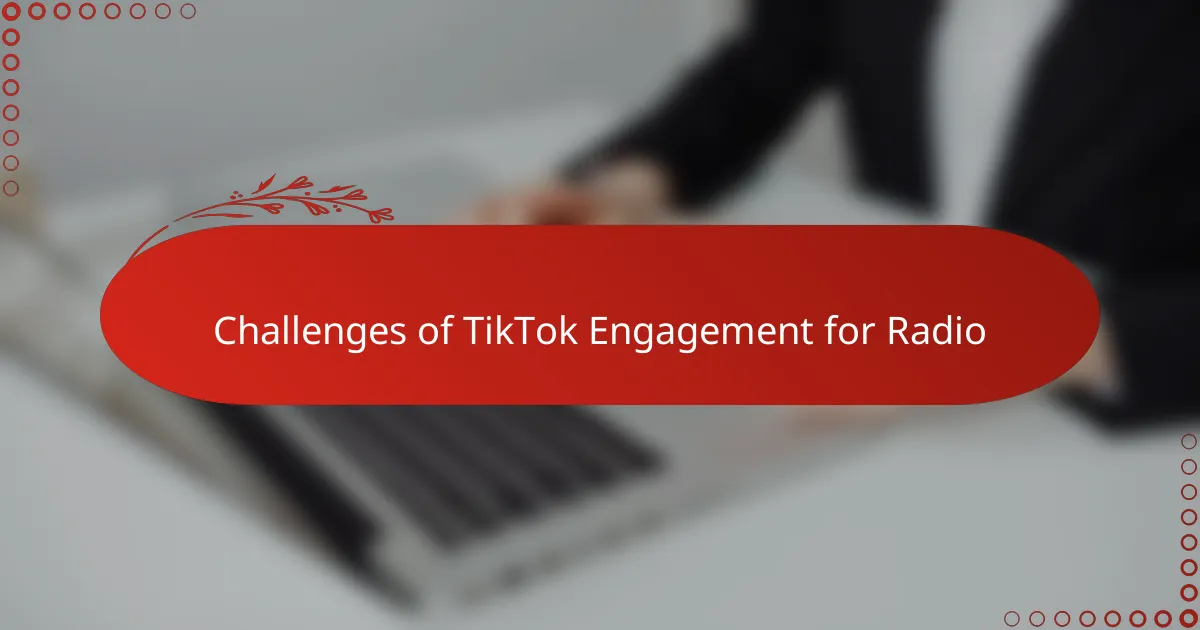
Challenges of TikTok Engagement for Radio
Engaging on TikTok presents a real challenge for radio because the platform’s visual-first nature clashes with radio’s audio-only roots. I’ve noticed it’s tough to translate the magic of just hearing a voice into something that captivates when viewers expect dynamic visuals. Have you ever tried to hold attention without flashy images? It’s not easy, and I often find myself scrambling for creative ways to make sound carry weight on screen.
Another hurdle is the sheer pace and style of TikTok content. Radio stories usually unfold slowly, building mood and detail, but TikTok demands instant hooks and rapid delivery. From my experience, this means either radically condensing content or losing the nuance that defines quality broadcasting. It sometimes feels like a race against the clock, where all the storytelling depth is sacrificed for quick wins.
Lastly, measuring success on TikTok can be frustrating for radio pros like me. Traditional radio gauges impact through ratings and listener feedback over time, while TikTok’s metrics are often superficial—likes, shares, views—that don’t always reflect genuine connection. I’ve asked myself, does a viral clip mean my audience is truly invested or just entertained for a moment? Sorting through this noise requires a new kind of patience and perspective, different from the radio world I’ve long known.
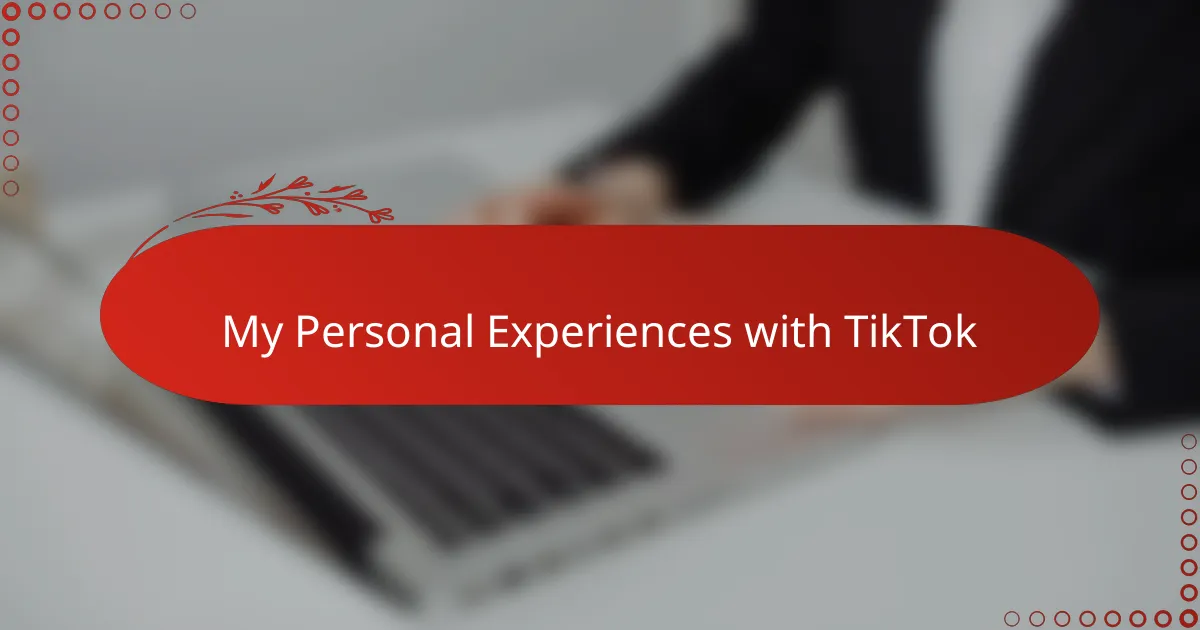
My Personal Experiences with TikTok
My first real experiment with TikTok was, honestly, both exciting and a bit intimidating. I remember posting a quick behind-the-scenes clip from the radio studio and watching how fast it spread—it was unlike anything I had seen with traditional broadcasting. That moment made me realize TikTok isn’t just a platform; it’s a space where radio can suddenly feel fresh and immediate.
At times, I’ve felt the pressure of TikTok’s fast pace, questioning whether my style could fit into such short bursts. Yet, every time I broke down a story or idea into 15 seconds, I discovered new ways to be concise without losing the personality that defines me on air. Have you ever found that constraints actually spark creativity? With TikTok, that’s been my experience over and over.
One thing that surprised me was how quickly the platform fosters interaction. I recall a simple video where I asked listeners about their favorite radio moments—within hours, the comments poured in. That real-time connection reminded me why I love radio in the first place: the shared experience, now amplified by TikTok’s community feel. It’s like rediscovering radio, but through a new, vibrant lens.
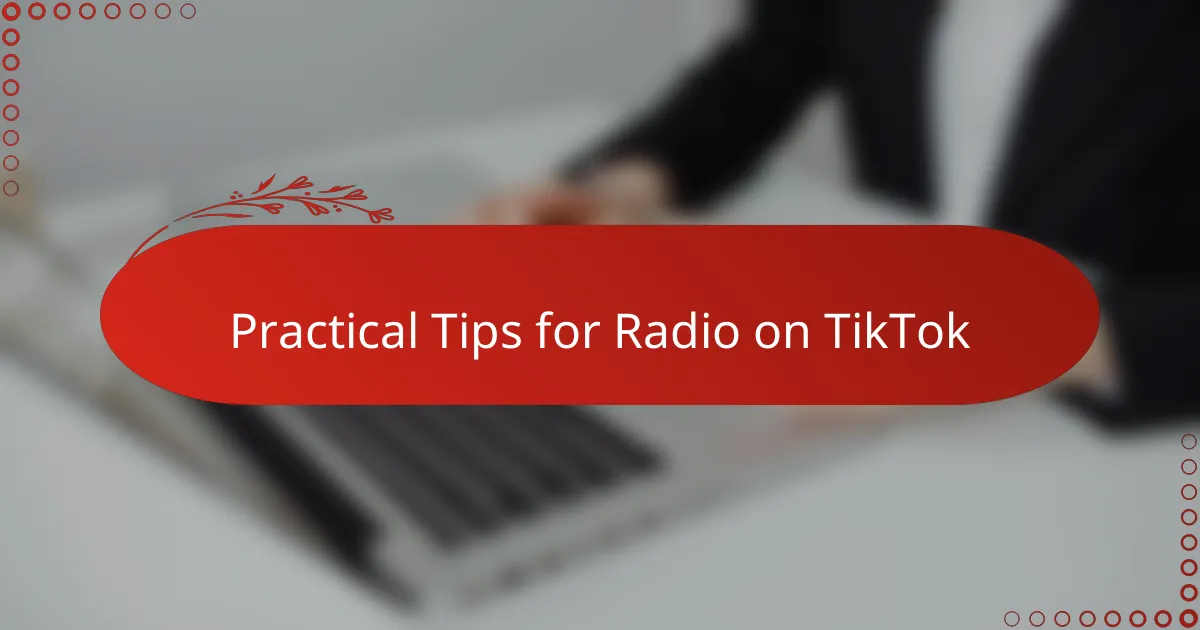
Practical Tips for Radio on TikTok
When I started adapting radio content for TikTok, I quickly learned that brevity is key. Instead of long monologues, I began creating quick, punchy clips that highlight a single idea or moment. Have you tried stripping your message down to its essence? I found it challenging at first, but it forces you to focus on what truly matters.
I also discovered that mixing visuals with familiar radio sounds can boost engagement significantly. Adding simple, relatable imagery—like studio shots or behind-the-scenes glimpses—makes radio content feel more tangible and real on TikTok. It’s fascinating how a short, candid video can build a connection that pure audio sometimes struggles to achieve.
Lastly, interacting with followers in the comments turned out to be a game changer for me. Responding to questions or using the duet feature to react to listener videos invites conversations that traditional call-ins rarely spark. Have you experienced how a quick reply can transform passive viewers into an active community? Engaging directly keeps the radio spirit alive in this fast-moving digital space.
